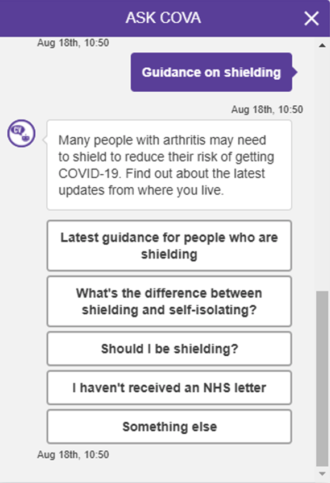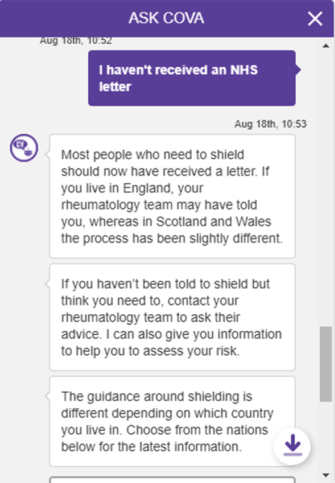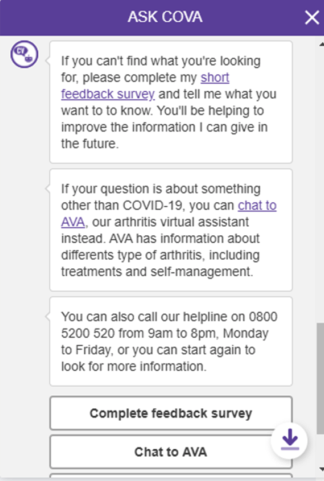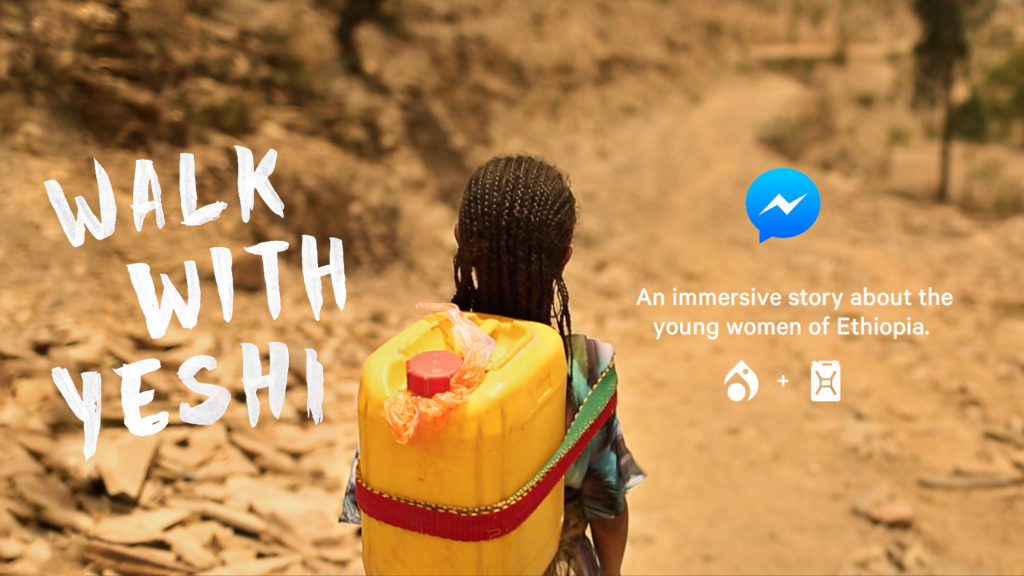Charity Chatbots in 2020: all talk or still worth a conversation?
Chatbots have been the next big charity digital trend for years now. Sure, chatbots have certainly made some waves in the charity sector, but in 2020, is this a digital tool every charity should be exploring, or a passing fad that’s already fading?
Covid chatbot at the ready
14 days was all it took for Versus Arthritis to create the first condition-specific COVID-19 chatbot. COVA provides users with reliable advice from the charity itself, and pools resources from the NHS, the government, and the British Society for Rheumatology, too. In its first two months, COVA provided vital information to over 3,000 people – how’s that for impact?!
Fortunately, COVA presented Versus Arthritis’ service users with the unique benefits that consumers expect to receive from chatbots: 24/7 support and immediate responses to queries. Chatbots like COVA are valuable tools for user-driven interactions that help consumers find what they want to know; they’re not just a new marketing channel to tell them what you want them to know.
Charities are no strangers to doing more with less – and in a time of recession and global change, it’s never been more needed. Chatbots can automate the more repetitive and straightforward help you offer, thereby freeing up valuable team time to do what only humans can: provide deeper, more empathetic support in more complex cases.
Rule-based vs. Natural Language Processing
First, let’s establish the types of chatbots that charities could use in their service offering.
Rule-based
COVA is a ‘rule-based’ chatbot, where users ask questions by tapping on pre-set message options. These are often called ‘scripted’ chatbots because the pre-set responses kickstart a ‘script’ that will be displayed, bit by bit, to the user. A drawback of this technology is the limited routes of conversation the bot can take. After hitting a dead end, users are referred to human support, often via telephone.



Natural language processing (NLP)
Natural language processing (NLP) chatbots are the alternative. NLP bots fall under the umbrella of Artificial Intelligence, as they are ‘taught’ how to navigate a script by processing the language in users’ typed replies. NLP chatbots need lots of training and in spite of their ‘intelligence’, still make mistakes. When selling plane tickets this isn’t the end of the world, but when supporting a vulnerable person who has just decided to seek help, it becomes more important.
Chatbot uses in the charity world
The first question to ask when considering a chatbot for your charity should be “What existing service is it replacing?” swiftly followed by, “Why is this better?”
Chatbots, and text-based interactions in general, are increasingly useful when reaching a younger audience. Younger generations are less comfortable talking on phones, and a conversation around a potentially stigmatised issue can feel easier with bot recipients.

We saw the very real need for this line of communication when designing and developing the Is This Ok? chatbot with charity partners Missing People, NSPCC and the formidable Sara Rowbotham. The chatbot helps teenagers at risk of criminal or sexual exploitation to find appropriate support quickly and discreetly, as we know conversations around grooming and abuse present huge challenges for vulnerable, young people.
We launched a pilot in a couple of small northern towns, and were shocked by the volume of uptake. The power of a chatbot in opening up this dialogue soon revealed itself.
In just three weeks, we saw:
- 600 young people get in touch (the majority of whom were aged 13-15 years old)
- Over 25% chose to be connected to a counsellor
- More than 10% got in touch during out-of-hours. In other words, the chatbot provided a communication channel that otherwise wouldn’t exist
A non-judgemental, digital service that can be used silently in a potentially abusive home or scenario was precisely what these vulnerable young people needed. A chatbot was the perfect first step in opening up this conversation.

In the past five years, chatbots have also taken on the role of storyteller. Charity:water’s immersive ‘Walk with Yeshi’, certainly changed the game, revolutionising the way donors connected with real beneficiaries in Africa.
Users followed Yeshi through GIFs, audio, videos, quizzes, images and text messages as she took her daily two and a half hour journey to collect clean water. Good old-fashioned storytelling has never been more important for charities, and Walk with Yeshi showed how to optimise the narrative in an innovative way via chatbot technology.
Not all good news
In addition to the aforementioned drawbacks to each type of chatbot, there are also less obvious, more complex issues with this relatively new technology.

Inclusivity
Problems often arise when chatbot creators overlook non-native speakers or regional/ethnic dialects. Much has been said about the ‘whiteness’ of AI in every respect, even down to what you’ll find when typing “robot” into Google Images. These biases have permeated the makeup of many chatbots over the years.
Like any charity service, chatbot creators must not only understand but ideally represent the end users to fully empathise with their needs. We recommend you approach this by sticking to Chayn’s principle “Design with, not for.”
Which platform?
Issues may also crop up when scoping out a platform for your charity chatbot.
Will the chatbot live somewhere on your own website? Or maybe you’re planning to host the bot on existing messaging platforms?
Facebook Messenger is generally a preferred external platform choice but if you’re contemplating the use of messaging platforms, these do pose risks that your charity needs to consider.
Depending on the nature of your charity and the data your users will provide – how comfortable are you with putting your trust in Facebook? Zuckerberg is less than popular on the internet right now, and social media is cropping up in new scandals seemingly every other week.
Additionally, rule changes occur frequently, such as the big wave of Facebook Messenger changes that were introduced late last year – a change which caused a decline in interest in the platform, from companies and charities alike.
It’s time to weigh up the risk vs. the reward. Building a chatbot from scratch may seem like a safer and more personalised option for sensitive conversations, but will require more resources. Messaging app bots are a cheaper option and target users on platforms they already use daily, but this may mean you never feel fully in control of the data, and are always at the mercy of the tech giants.
The future
What comes next for charity chatbots? Will chatbots take on the role of group therapist – posing questions and then sitting back, teaching groups of friends how to talk openly about their feelings in the process? This is just one of the many possibilities as charities find innovative new roles for bots.
The more information and resources they possess, the better chatbots operate so wouldn’t it be great to see partnerships between charities that create super-informed bots that give tailored and relevant help to shared audiences, and then signpost them to the right charity support.
Chatbots haven’t reshaped the world just yet. But we do know that they have changed lives, and told incredibly compelling stories that ignite a real desire in people, to help.
